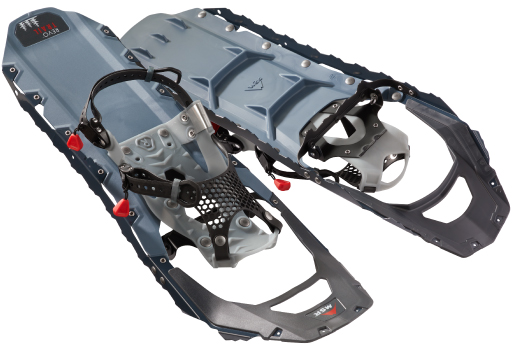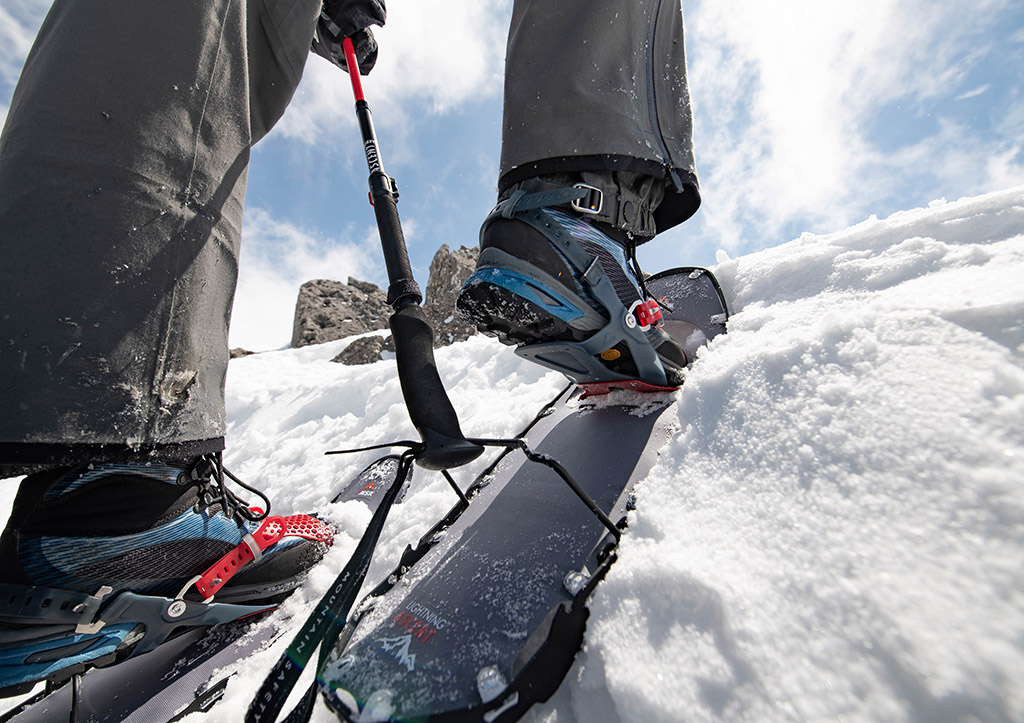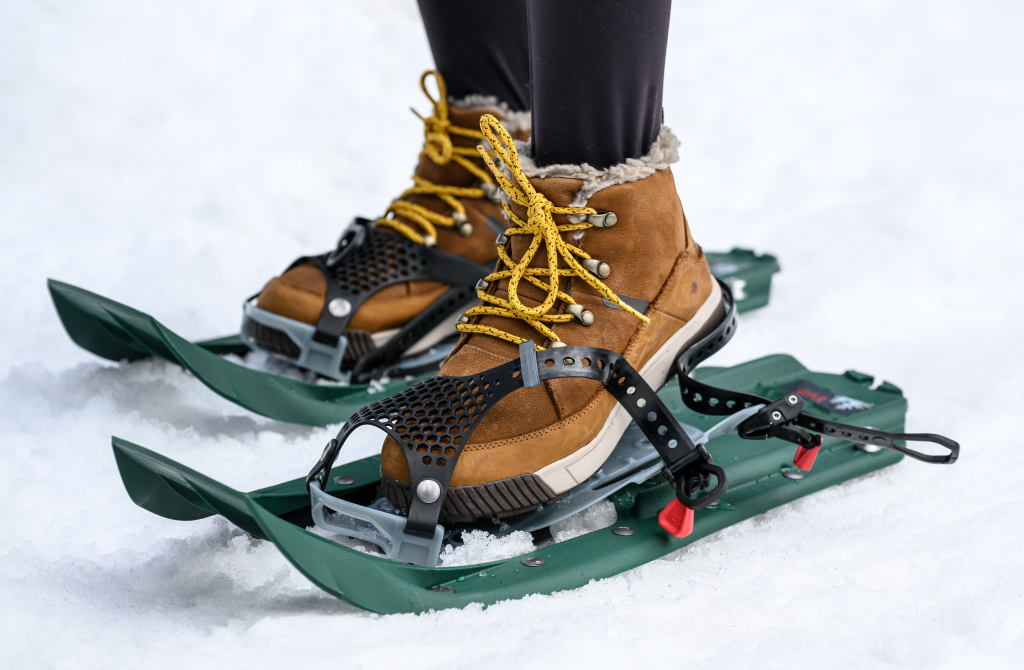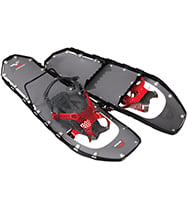How to Choose the Right Snowshoes
Whether you’re a serious explorer who likes to spend long days in the backcountry, a weekend warrior headed out for a day hike, or you’re bringing the whole family on an adventure, snowshoeing can be the perfect mode of winter travel. Simple to use, snowshoes allow you to cross snow-covered ground quickly and efficiently by providing flotation, spreading your weight evenly across their wide, flat surfaces. There are a few different styles of snowshoes to choose from and selecting the ideal set—with the features you want—will maximize your experience. Let’s take a look at how to choose snowshoes.

Step 1: Choose where you’ll be snowshoeing
MSR’s snowshoes fall into three categories based on your intended terrain: Will you be walking along flatter terrain like cat tracks and lowland trails; winter hiking on or off the trails on day and extended trips; or accessing rugged backcountry terrain and mountain climbing?

Flat Terrain Snowshoes
Best for minimalists and recreationalists on flat trails or rolling hills.
If your winter excursions are primarily on mellow terrain, MSR’s Trail Series is a great choice. With easy-to-adjust, comfortable bindings and fewer features, these are great for long-distance snowshoers looking to shed weight or casual snowshoers exploring their local woodlands and valley basins, who need only essential easy-to-use performance.

Rolling Terrain Snowshoes
Best for hiking on and off-trail, with a priority on comfort for all-day adventures.
For hikers and backpackers who like to spend long days on or off the trails in variable snow conditions and terrain, MSR’s Explore Series is the way to go. This series offers a great combination of all-day comfort, extra features for hiking on slopes, and a fast, easy on-off binding that makes getting in and out a breeze. These are great all-around snowshoes for winter exploration.

Mountain Terrain Snowshoes
Best for mountaineering, backcountry pursuits and rugged terrain.
Whether you’re bagging peaks or headed up the mountain in search of fresh powder, when you’re serious about ascending you’re looking for a snowshoe with maximum traction, rugged bindings and ultralight performance. The MSR Ascent Series is the perfect fit. Designed specifically for backcountry pursuits with extra-secure and comfortable bindings, and reliable durability, every snowshoe in this series can be paired with either plastic mountaineering boots or the footwear of your choice.

Step 2: Choose Snowshoe Size
Once you’ve decided on the snowshoe model you want, let’s look at how to choose the right size.
Sizing by Snow Type and Weight
Both the snow type you expect to encounter as well as the load weight you’ll be carrying will affect the size of snowshoe you select. For drier snow and heavier loads, you’ll need a larger snowshoe surface area, and for lighter loads and wetter conditions, you’ll be looking for a smaller area.
- Packed trails: Choose smaller snowshoe sizes for easy maneuverability.
- Steep or icy terrain: Smaller is better for agility in high-consequence situations.
- Powder snow: Look for larger sizes for more flotation in light and dry conditions.
To maximize agility and efficiency look for the smallest size that will support your weight (including gear and clothing) in your most commonly chosen snow conditions and terrain. If you’re between sizes or need a boost for a powder-filled or heavy-pack trip we offer Modular Flotation tails available for all MSR adult snowshoes.
Sizing by Gait
- Men’s snowshoes: These are sized for carrying heavier loads and accommodating larger footwear.
- Women’s snowshoes: These feature narrower frames that offer greater agility and a more natural stride for those with a narrow gait; they’re also ideal for anyone seeking the lightest snowshoe possible.
- Kids’ snowshoes: MSR’s Youth Series are sized-down versions of the MSR adult line, engineered to the same exacting standards.

Step 3: Choose performance features
Frames and Decking
The frame is the outermost edge of the snowshoe, while the deck is the flat inner material that provides surface area for flotation.
MSR’s snowshoe lineup offers three types of platforms: Our Lightning™ snowshoes feature an ultralight aluminum frame and nylon decking for fast-and-light travel. Our Revo™ snowshoes feature a steel frame and an ultra-rugged plastic deck to provide streamlined performance and durability. And our Evo™ snowshoes feature a one-piece injection-molded plastic deck that is super durable for years of snowshoeing adventures, perfect for people who are tough on their gear.
Traction
Snowshoes are designed with a variety of traction components to ensure safe and efficient travel, especially on higher consequence terrain such as steep slopes and sidehill traverses.
Where the traction is located on MSR snowshoes:
- Toe or instep crampons: The main source of snowshoe traction, toe crampons are located underneath the binding platform and are designed to rotate with it and gain purchase as you climb.
- Side rails/traction bars/traction teeth: Located around the decking’s edge, these teeth provide extra traction, especially on traverses.
- Braking bars: Found under the snowshoe behind the foot, these provide forward traction and prevent backsliding.
MSR’s Ascent Series and Explore Series have more advanced traction for mountain terrain.

Heel Lifts / Climbing Bars
To relieve calf strain and save energy on ascents these wire bars can be flipped up under your heels (pro tip: use the handle of your trekking pole to flip them up). Using them also increases your traction on steep slopes, keeping your weight squarely on the snowshoe. On MSR models, these are called “Televators” and can be found on the Ascent Series and Explore Series.
Bindings
There are a few different styles of snowshoe bindings, each optimized for varying levels of security, comfort and ease of use. All MSR bindings utilize a variation of Rotating (or Floating) Bindings, which allow the binding to pivot freely on its deck. This causes the tail to fall away and shed snow with each step, in turn reducing the overall energy you need to expend (snow is heavy).
MSR Bindings:
- DuoFit™ Bindings: Available on the Youth Series, these classic two-strap bindings are perfect for walking along flat trails. They’re light and very easy to use with gloves on.
- Paraglide™ Bindings: Our lightest bindings, available on the Trail Series and designed for ease of use and comfort for newer snowshoers while providing a secure fit. They provide a pressure point-free hold that is compatible with nearly any footwear, from light hikers to snowboard boots.
- HyperLink™ Bindings: With a quick and easy ratchet system and cushioned cradle, these bindings are great for all-day adventures. They’re available on the Explore Series.
- Paragon™ Bindings: Designed for aggressive ascents and ultra-secure all-terrain stability, these are available on our Ascent Series.
Snowshoes We Recommend:
Choose your snowshoes based first on the terrain you plan on being in most often. The Trail Series is best suited to flat or rolling terrain, the Explore Series excels at off-trail travel and puts a priority on comfort and fast, easy use. And the Ascent Series is perfect for more serious mountain travel.
Next, choose the deck type that suits your needs—opting for the ultradurable injection-molded plastic Evo deck, the streamlined steel and plastic Revo deck, or the ultralight weight savings of the aluminum Lightning deck. Once you’ve chosen the series and deck type, choose the smallest snowshoe size that will support your carrying weight, typical snow type (packed, icy, or powder) and gait type (wide or narrow).
Keep in mind you can always extend the flotation of your chosen snowshoes with MSR Modular Flotation tails.
- Minimalists and recreationalists on flat trails or rolling hills: Trail Series
- Hiking on and off-trail; all-day comfort & ease of use on extended trips: Explore Series
- Mountaineering, aggressive backcountry pursuits and rugged terrain: Ascent Series
- Passing on your love of the outdoors to the next generation: Shift for Youth, Tyker for children up to 90 lbs.
- For extending the flotation of your current MSR snowshoes: Modular Flotation Tails

Related Posts:
- Perfecting Your Snowshoe Binding Fit
- Choosing the Right Snowshoes for Every Adventure
- MSR Lightning vs Revo Snowshoes: What’s The Difference?
—
 About the Author
About the Author
As a freelance writer and designer, Claire Montana Jencks works with outdoor brands, non-profits, and publications to share stories of outdoor adventure. Though she works all over the world, her roots are in the PNW. Surfing, mountain biking, and skiing are her passions.
Updated. Originally published Dec 9, 2021.




